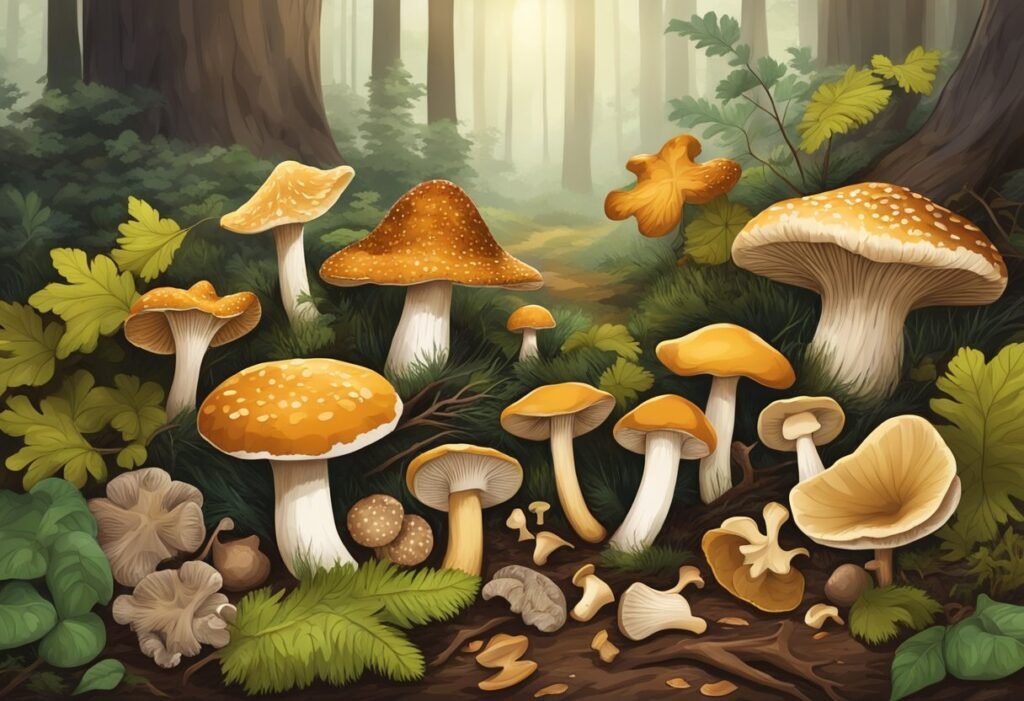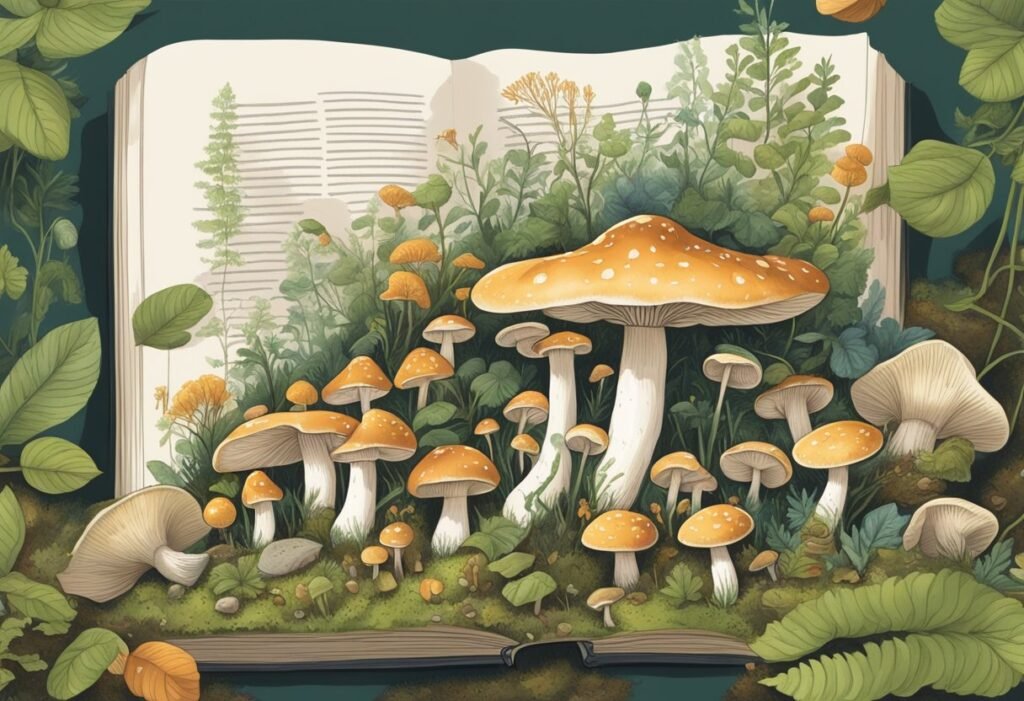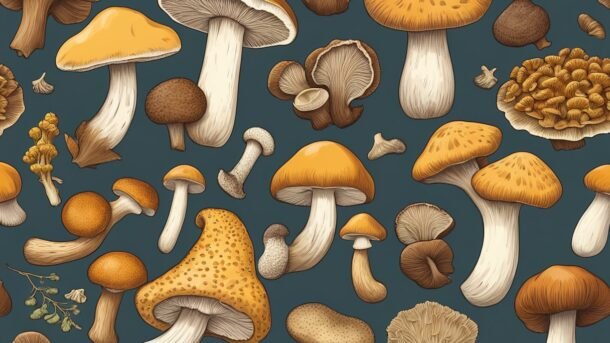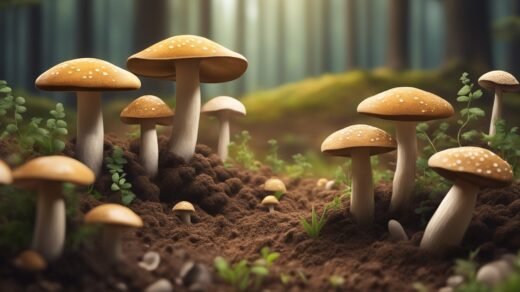Mushrooms are a popular ingredient in many different types of cuisine, but not all mushrooms are safe to eat. In fact, some mushrooms are highly toxic and can cause serious illness or even death if consumed. It is important to know which mushrooms are safe to eat and which ones should be avoided.
There are many different types of edible mushrooms, ranging from common button mushrooms to more exotic varieties like shiitake and chanterelle. Some mushrooms are easy to identify and are commonly sold in grocery stores, while others are more difficult to find and may only be available at specialty markets or through foraging.
Knowing which mushrooms are safe to eat can be a challenge, but there are a few key things to keep in mind. First, it is important to only eat mushrooms that have been properly identified as safe to consume. If you are unsure about a particular mushroom, it is best to err on the side of caution and avoid eating it. Additionally, it is important to properly clean and cook mushrooms before eating them to ensure that any potential contaminants or toxins are destroyed.
Overview of Edible Mushrooms

Characteristics of Edible Mushrooms
Edible mushrooms are fungi that are safe to eat and are widely used in culinary preparations. They are known for their unique flavors and textures, making them a popular ingredient in many dishes. Edible mushrooms have some common characteristics that differentiate them from other types of mushrooms. They have a fleshy cap and a stem, and their gills are located underneath the cap. Edible mushrooms are also known for their distinctive aroma and flavor.
Common Edible Mushroom Species
There are many different species of edible mushrooms, and some of the most commonly consumed types include:
- Button mushrooms (Agaricus bisporus): These are the most common type of mushroom found in grocery stores. They have a mild flavor and a firm texture, making them versatile for use in many dishes.
- Portobello mushrooms (Agaricus bisporus): These are mature button mushrooms that have a larger cap and a meatier texture. They are often used as a vegetarian substitute for meat in dishes like burgers and sandwiches.
- Shiitake mushrooms (Lentinula edodes): These mushrooms are native to East Asia and have a meaty texture and a rich, earthy flavor. They are often used in stir-fries, soups, and other Asian dishes.
- Oyster mushrooms (Pleurotus ostreatus): These mushrooms have a delicate texture and a mild flavor. They are commonly used in soups, stews, and sauces.
- Morel mushrooms (Morchella spp.): These mushrooms have a distinctive honeycomb-like appearance and a nutty, earthy flavor. They are often used in gourmet dishes and are highly prized by chefs.
Overall, there are many different species of edible mushrooms, each with their own unique flavors, textures, and uses in culinary preparations. It is important to properly identify and prepare mushrooms before consuming them to ensure safety.
Foraging Guidelines

Safety Tips for Mushroom Foragers
Mushroom foraging can be a fun and rewarding experience, but it is important to take precautions to ensure your safety. Here are some tips to keep in mind:
- Always be certain of the identification of a mushroom before consuming it. Some mushrooms can be highly poisonous and can cause serious illness or even death.
- Use a field guide or consult an expert to help you identify mushrooms. It is also a good idea to take a mushroom identification course.
- Wear protective clothing, such as gloves and long sleeves, when handling mushrooms. Some mushrooms can cause skin irritation or allergic reactions.
- Do not eat mushrooms that have been growing near contaminated areas, such as roadsides or industrial sites.
- Do not pick mushrooms that are too old or have been damaged by insects or animals. These mushrooms may contain harmful toxins.
Habitats and Seasons
Different types of mushrooms grow in different habitats and at different times of the year. Here are some general guidelines to keep in mind:
- Many mushrooms grow in wooded areas, particularly in damp or moist soil. Look for mushrooms near fallen trees or decaying organic matter.
- Some mushrooms, such as morels, grow in open fields or grassy areas.
- Most mushrooms grow in the fall, but some species can be found in the spring or summer.
- Keep in mind that weather conditions can affect mushroom growth. Mushrooms tend to grow after periods of rain or high humidity.
By following these guidelines, mushroom foragers can safely and successfully identify and collect edible mushrooms.
Health Benefits and Nutritional Value
Mushrooms are not only delicious but also packed with essential nutrients. They are low in calories and high in vitamins, minerals, and antioxidants. Mushrooms can be a great addition to a healthy diet, and they offer numerous health benefits.
Nutritional Components
Mushrooms are rich in many essential nutrients, including:
- Protein: Mushrooms are a good source of protein and contain all the essential amino acids required by the body.
- Fiber: They are also high in fiber, which is essential for maintaining digestive health.
- Vitamins: Mushrooms are a good source of B vitamins, including riboflavin, niacin, and pantothenic acid. They also contain vitamin D, which is essential for strong bones and teeth.
- Minerals: Mushrooms are rich in minerals such as potassium, phosphorus, and selenium.
Medicinal Properties
Mushrooms have been used for medicinal purposes for centuries. They contain various compounds that have been shown to have medicinal properties, including:
- Beta-glucans: These are complex sugars found in the cell walls of mushrooms. They have been shown to have immune-boosting properties and may help to reduce inflammation.
- Polysaccharides: These are complex carbohydrates found in mushrooms. They have been shown to have anti-tumor and anti-cancer properties.
- Ergothioneine: This is an antioxidant found in mushrooms that has been shown to protect cells from oxidative damage and may help to reduce the risk of chronic diseases such as cancer and heart disease.
In conclusion, mushrooms are not only delicious but also offer numerous health benefits. They are a good source of essential nutrients and contain compounds that have been shown to have medicinal properties. Adding mushrooms to your diet can be a great way to improve your overall health and well-being.
Culinary Uses
Mushrooms are a versatile ingredient that can be used in a variety of dishes. They can be sautéed, grilled, roasted, or even served raw in salads. The flavor of mushrooms is enhanced by cooking, and they can be used to add depth and complexity to a dish.
Preparation and Cooking Methods
Before cooking, it is important to properly clean and prepare mushrooms. They should be wiped clean with a damp cloth or paper towel to remove any dirt or debris. Mushrooms should not be washed, as they can absorb water and become soggy.
One popular method for cooking mushrooms is sautéing. To sauté mushrooms, heat a small amount of oil or butter in a pan over medium-high heat. Add the mushrooms and cook until they are tender and browned, stirring occasionally.
Grilling is another great way to prepare mushrooms. Simply brush them with oil and season with salt and pepper before grilling over medium-high heat for a few minutes on each side.
Mushrooms can also be roasted in the oven. Toss them with oil and your favorite seasonings before roasting at 400°F for about 20 minutes, until they are tender and golden brown.
Preservation Techniques
Mushrooms can be preserved in a variety of ways, including drying, freezing, and canning. Dried mushrooms can be rehydrated and used in soups, stews, and sauces. Frozen mushrooms can be added directly to dishes without thawing, making them a convenient ingredient to have on hand. Canned mushrooms are also available, but they may not have the same flavor and texture as fresh mushrooms.
In conclusion, mushrooms are a versatile and flavorful ingredient that can be used in a variety of dishes. With proper preparation and cooking techniques, they can add depth and complexity to any meal.
Risks and Considerations
When foraging for mushrooms, it is important to exercise caution and take necessary precautions to avoid consuming poisonous mushrooms. Some mushrooms may have poisonous look-alikes that can be difficult to distinguish from edible varieties. Additionally, some individuals may experience allergic reactions or intolerances to certain types of mushrooms.
Poisonous Look-Alikes
There are several types of mushrooms that have poisonous look-alikes, making it important to be able to identify the specific characteristics of each type. For example, the deadly Amanita mushroom has a very similar appearance to the edible Caesar’s mushroom. However, the Amanita mushroom has a distinctive ring around the stem and a bulbous base, while the Caesar’s mushroom does not.
Other poisonous mushrooms that have look-alikes include the Jack O’Lantern mushroom, which looks similar to the edible chanterelle mushroom, and the False Morel mushroom, which resembles the edible Morel mushroom. It is recommended to consult with an experienced forager or mycologist before consuming any wild mushrooms.
Allergic Reactions and Intolerances
While most people can safely consume edible mushrooms, some individuals may experience allergic reactions or intolerances. Symptoms of an allergic reaction may include hives, difficulty breathing, and swelling of the face, lips, tongue, or throat. Intolerances may cause symptoms such as nausea, vomiting, diarrhea, or stomach pain.
It is important to be aware of any potential allergies or intolerances before consuming mushrooms. Individuals with a history of allergies or intolerances should consult with a healthcare professional before consuming any type of mushroom. Additionally, it is recommended to start with small amounts of a new type of mushroom to gauge any potential reactions before consuming larger amounts.




